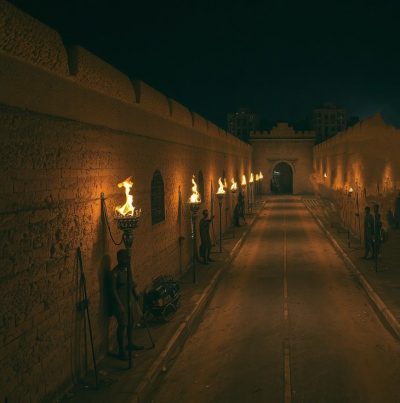Kingdoms and Monuments: The Great Walls of Benin (Nigeria)

The walls of Benin stood 18 meters tall and ran more than 15000km around the city (Imagined by AI)
The Great Walls of Benin: A Beacon of African Cultural Legacy
Long before the rise of modern cities and industrialized defenses, the ancient Kingdom of Benin, located in present-day southern Nigeria, stood as a model of urban planning, cultural sophistication, and military innovation. One of its most extraordinary legacies is the Great Walls of Benin, a colossal system of fortified earthworks. This immense construction is a premier example of African heritage sites, built to protect one of the most influential African kingdoms of its time and to tell one of the untold African stories of pre-colonial genius.
A Marvel in Stone and Earth: Origins and Scale
Construction of the Benin Walls began as early as 800 AD and continued into the late 15th century, around 1473. Built entirely by hand, using earthworks that included deep moats and tall embankments, these walls were an astounding feat of pre-colonial engineering. Spanning over 6,000 square kilometers, the wall complex surrounded Benin City, the ancient capital of the Kingdom of Benin. With some sections reportedly reaching heights of 18 meters, the structure was more than just a defense mechanism; it was a profound testament to the architectural genius and organizational strength of the Edo people, showcasing their African cultural legacy.In terms of length and historical importance, the Benin Walls surpassed even the Great Wall of China.Military and Social Function: A Rich Layer of Untold African Stories
The walls served a dual purpose that reflects the complexity of the kingdom. First, they were a fortified barrier, protecting the kingdom from slave raiders and hostile neighbors. Second, they reflected a sophisticated urban plan, with a complex network of interconnected roads, gates, and ring routes. This intelligent design is a vital part of the African cultural legacy of the Edo people.
The inner and outer walls were interconnected, and the design featured guarded gates, moats, and watch posts to monitor threats. Inside the capital, an intricate network of 30 straight roads connected the city’s core to its surrounding settlements. Each road met the walls at a right angle, facilitating easy movement, trade, and military coordination. These details are crucial for understanding the untold African stories of advanced governance and social order.
European Visitors in Awe: An African Heritage Site of Urban Excellence
When Dutch explorer Dierick Ruiters visited Benin in 1602, he was stunned by the city’s urban planning. He noted that the thoroughfares in Benin were up to seven times wider than Amsterdam’s main streets, with some measuring an impressive 120 feet across.
Such testimonies dismantle the colonial myth of pre-modern African societies as “uncivilized.” Benin’s layout showcased not only advanced city planning but also the high social order and functional governance of the kingdom, solidifying its place among the most significant African heritage sites.
1897: Interruption of an African Cultural Legacy
The beginning of the end came in 1897 when a British punitive expedition invaded Benin City. The British army, armed with modern weapons and overwhelming firepower, burnt the city to the ground, destroyed sections of the walls, and looted the royal palace. Thousands of priceless artworks, known as the Benin Bronzes, were stolen, with many still sitting in European museums today. This marked a tragic, violent interruption of one of the most advanced civilizations in pre-colonial Africa. The Walls of Benin remain a painful reminder of this loss, but also an enduring symbol of the kingdom’s brilliance and a testament to its vibrant African cultural legacy.
Legacy and Preservation: Reclaiming African Heritage Sites
Efforts are now underway to preserve and reconstruct parts of the Benin Walls, as well as to repatriate the stolen Benin Bronzes from foreign museums. The Nigerian government, in partnership with global institutions, is actively engaging in cultural restitution and historical justice to protect this precious African heritage site.
These walls remind us that Africa was, and still is, a birthplace of ingenuity and civilization. They challenge us to reclaim our narrative, protect our heritage, and amplify the genius of our ancestors. The Walls of Benin were not just structures of clay and earth; they were expressions of a people’s spirit and an empire’s vision. They continue to inspire pride across the African continent and diaspora, helping to bring more untold African stories to light.
Support the campaign for cultural justice! Share this article to help amplify the untold African stories of the Kingdom of Benin and advocate for the return of the looted Benin Bronzes to Nigeria.
#WallsOfBenin #AfricanHeritageSites #AfricanCulturalLegacy #UntoldAfricanStories #BeninKingdom #CulturalRestitution #BeninBronzes #PreColonialAfrica
Watch this video for more. You might also like Biete Ghiorgis – Church of Saint George, Lalibela
